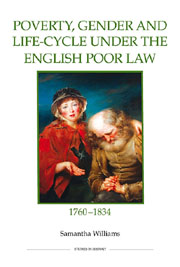Book contents
- Frontmatter
- Contents
- List of figures
- List of tables
- Dedication
- Acknowledgements
- Abbreviations
- Map 1 Bedfordshire, c.1834
- Introduction
- 1 People, place and poverty
- 2 Policy and paupers
- 3 Paying for poverty
- 4 Gender, life-cycle and the life-course
- 5 Work, unemployment and the makeshift economy
- Conclusion
- Bibliography
- Index
2 - Policy and paupers
Published online by Cambridge University Press: 05 February 2013
- Frontmatter
- Contents
- List of figures
- List of tables
- Dedication
- Acknowledgements
- Abbreviations
- Map 1 Bedfordshire, c.1834
- Introduction
- 1 People, place and poverty
- 2 Policy and paupers
- 3 Paying for poverty
- 4 Gender, life-cycle and the life-course
- 5 Work, unemployment and the makeshift economy
- Conclusion
- Bibliography
- Index
Summary
Social welfare expanded considerably in the south and east in the seventeenth and eighteenth centuries, but started to contract during the early nineteenth. This chapter explores the extent to which Campton and Shefford conformed to this picture by means of an in-depth analysis of all aspects of parish expenditure: the policy of the parish vestry, trends in expenditure, numbers relieved and the categories of spending. The pauper biographies are analysed quantitatively in order to put together a picture of the changing nature of the pauper host: who exactly was relieved and how generously, what were their family circumstances, and how did this change over the seven decades of this study? In this context the effect of the Poor Law Amendment Act of 1834 is crucial. Did it mark a radical departure in terms of levels of ‘generosity’, policy and attitudes towards the poor?
Parish policy and payments
Despite rapid growth in provision in both Campton and Shefford, there is little direct evidence of parish officials trying one method to relieve the poor and then another, such as switching between direct outdoor relief and workhouses contracted to a workhouse master, as happened in some other parishes within Bedfordshire and elsewhere. Almost all parish assistance in Campton and Shefford was outdoor relief given as cash pensions (weekly), occasional cash sums and payments in kind. Only a handful of the poor was housed in poor houses in both communities, but these were more like modern council houses than workhouses, and those accommodated were usually the transient and the expenditure on them small, never exceeding 6 per cent of total spending.
- Type
- Chapter
- Information
- Publisher: Boydell & BrewerPrint publication year: 2011

